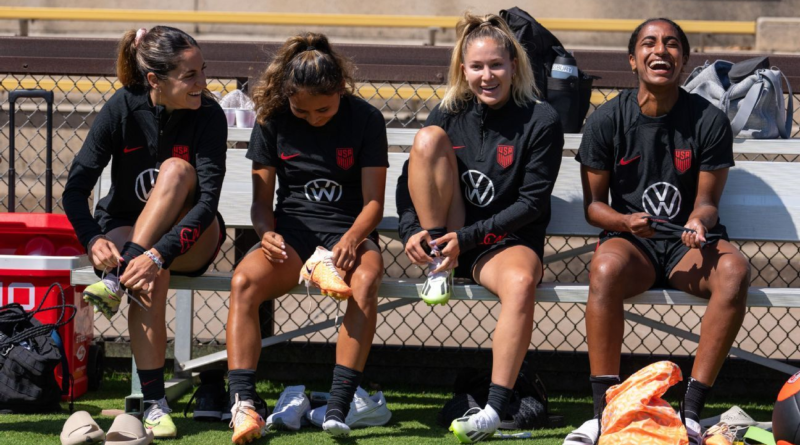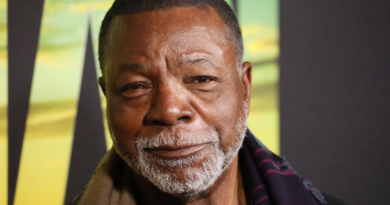USWNT hopes diverse squad will inspire underrepresented girls
On the field, the U.S. women’s national team has much to prove at this month’s World Cup.
As back-to-back champions, there’s immense pressure on the youthful group of players aiming to win an unprecedented third title in a row. Off the field, though, non-sporting goals have already been scored.
“It’s crazy how diverse this team has become with how many African-Americans there are, Mexican-Americans,” 21-year-old Washington Spirit forward Trinity Rodman said earlier this month. “It’s expanding and I think that shows so much that it’s not exclusive.”
NJ/NY Gotham FC‘s Lynn Williams noted, “When I was growing up, there wasn’t a lot of Black people playing soccer, let alone on the national team to look up to. It’s just awesome that the national team is starting to look like the nation.”
As part of a wider generational shift for the USWNT, the squad that will be heading to Australia and New Zealand for the FIFA Women’s World Cup is not only younger than usual, but more ethnically diverse.
– Stream on ESPN+: LaLiga, Bundesliga, more (U.S.)
Criticized in the past for lacking representation — “Why is the U.S. women’s World Cup roster so white?” read one headline from the 2019 tournament — this year’s roster highlights a wider range of backgrounds that can help push for more inclusivity in the sport. That representation, on the biggest stage in women’s sports, matters, especially when you consider that roadblocks remain for minorities who want to access soccer in this country.
Facing hurdles at an early age
During a Project Play Summit — an effort to build healthy communities through sport — last May, U.S. Soccer Federation president Cindy Parlow Cone outlined a challenge that has yet to be overcome in the United States.
“How do we shift that thinking from that [soccer is] a rich white kids’ sport, to this is a sport that is literally played in every country around the world,” Parlow Cone asked. “As the most diverse country in the world … how do we change that focus to making sure that every kid feels welcomed into our game?”
On a global scale, soccer typically permeates almost every demographic in every country, but in the U.S., organized versions of the game are typically seen as a costly endeavor in youth sports. Issues with access make it difficult in an often referenced “pay-to-play” setup, which can block entry for minorities.
“It’s very expensive,” said Ashley Sanchez, a Mexican American midfielder for the USWNT. “I think that everyone could do a better job of just giving opportunities to everyone.”
Registration, gear, camps, travel — these costs quickly add up. A survey in the fall of 2022 from Project Play found that families spent an average of $1,188 per youth soccer season, which was more than basketball, baseball and American football.
In a 2020 article, Yahoo Sports found that the 161 clubs in the U.S. Soccer Development Academy were located in ZIP codes that, on average, had median incomes that were more than 60% higher than the nationwide average.
Despite all this, does more representation in the USWNT mean progress is being made on the paths leading up the senior squad? Or is it more of a coincidence for this specific roster?
“I think there’s multiple truths that can obviously all exist,” full-back Crystal Dunn said. “I think it’s not just one thing. I think more awareness of the sport in minority neighborhoods is something that I’ve been always backing because I think having access to this sport at a young age is ultimately what allows women of color to stay in this game, and I think there’s an amazing moment right now in the women’s game where there is more diversity.”
“As a woman of color, I know that I struggled with feeling like I have this place of belonging in the women’s game. I think when I look around and I see all the women of color on the team currently, it’s a beautiful thing and it’s something that we fought long and hard for. I think we still have a way to go. We’re not going to be complacent.”
‘Soccer is a space for anybody’
Inclusion is vital for not only providing a path for a wider range of up-and-coming athletes, but for also making them feel comfortable in their surroundings. It’s obvious that players need to feel content and at ease in their environment to succeed, and that can be difficult in a more homogeneous setup.
“I think there were moments where I felt like I needed to conform to the environment and say, ‘OK, let me tone down who I am because I feel like there’s very few of us on this team,’ and I think the best thing that I learned to do is really just show up as my most authentic self,” Dunn said. “I think as a woman of color, it’s like, I can’t hide that I’m a Black woman.
“Sometimes I feel like even speaking about topics that I know probably only relate to me, and it’s not knowing kind of how to really express it. … It doesn’t have to be anything deep and dark or whatever but it’s just like, you know, finding a hairstylist and all of a sudden I’m looking around and I may be the only one [on the team] that’s looking for the hairstyle that I need them to do. So it’s little things like that I feel like people don’t even think about.”
There are, of course, bigger things to challenge as well.
In recent years, the Black Women’s Player Collective, a nonprofit founded in 2020 that is made up of NWSL players, have taken it upon themselves to help enact change. With Dunn and Williams moving things in the right direction as part of their board, the group has pushed initiatives such as uplifting voices in their community, providing mentorship opportunities and also working with other organizations to build mini-pitches across the country.
2:15
The person Ali Krieger is picking as USWNT’s most dangerous player
Ali Krieger reveals her pick for USWNT’s most threatening player heading into the World Cup in Australia and New Zealand.
“I think that the work of the BWPC gets the word out that soccer is a space for anybody who wants to be a part of the game,” Williams said.
The group can help add more viewpoints and backgrounds that are important for the future of the USWNT. It allows for continued conversations from high-profile figures who have already fought for social causes in the past, such as gender equity. As role models who are the children of immigrants and minorities, they can also have a greater impact that is already influencing the next generation of stars.
Center back Naomi Girma, 23, the daughter of Ethiopian parents, felt energized by the past activism of the senior players. While a student-athlete at Stanford, Girma spoke up about Black Lives Matter and took part in events such as a conversation with the nonprofit Soccer Without Borders.
“I think me being at Stanford and speaking out about important social justice issues was a big result of me seeing the national team doing that,” she said. “And I think being able to have them as role models growing up and seeing how they used their platforms inspired me.”
Guiding the next generation
With a chance to lift another World Cup as millions watch on around the globe, there’s going to be an opportunity to inspire future USWNT stars who can be a part of their growing melting pot. Sofia Huerta, a dual national who played for Mexico on five occasions, believes there’s power in her name alone when it comes to creating more diversity in the future.
“I’m really proud to represent the Latinx community, and I hope that all the little girls and boys that see ‘Huerta’ on the back of my jersey know that they can accomplish anything that they want to,” the OL Reign full-back said.
“I think this is a good stepping stone,” Sanchez added of the growing visibility of Mexican Americans in the team, “but obviously we want a lot more and I hope that this isn’t even a conversation at some point and it’s just the usual.”
The goal is to encourage underrepresented kids, to show them that there’s a place for them in this game.
“It’s extremely important,” Rodman said of diversity in women’s soccer. “I think, too, the young girls that look up to me and a lot of girls that look like me, I see 10 to 20 girls after every single game that look like — could be my sisters. I just look at them and I smile.”
Now that non-sporting goals have been scored, thanks to the efforts of these players and the changing composition of the USWNT, let’s see what the team can do on the field.
“This team, it’s the best players in the country, it doesn’t matter what you look like,” said Sophia Smith, a 22-year-old forward with the Portland Thorns who could be one of the breakout stars of the World Cup. “If you’re good enough, you’re good enough, and I would like to believe that that’s what’s happening at youth levels, too.”




